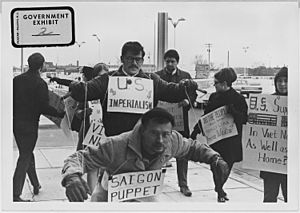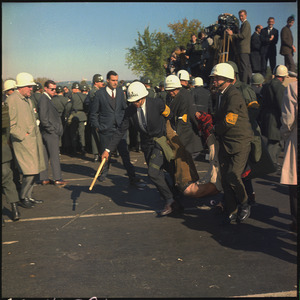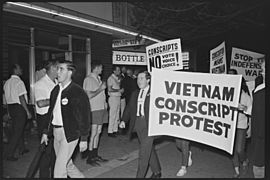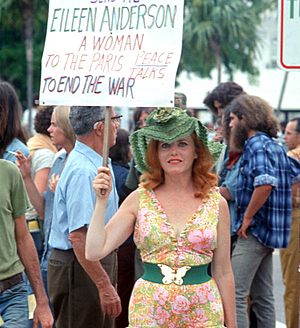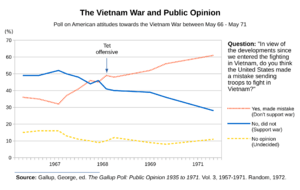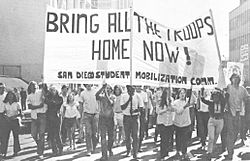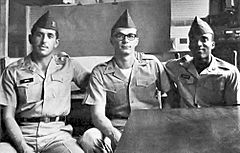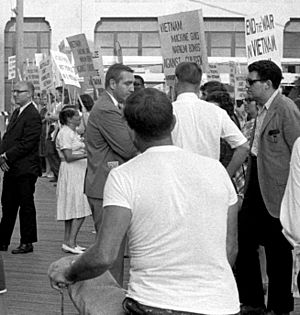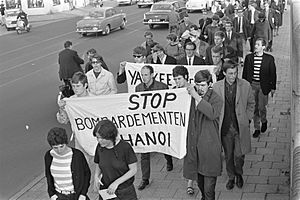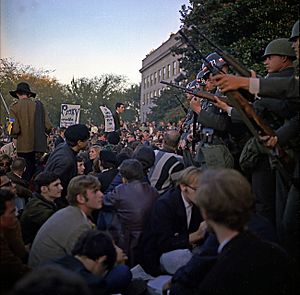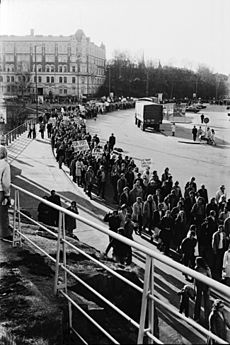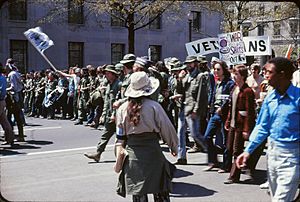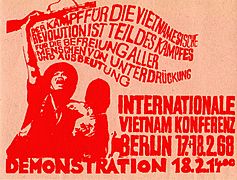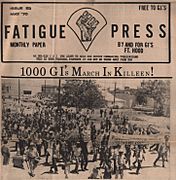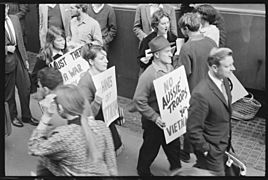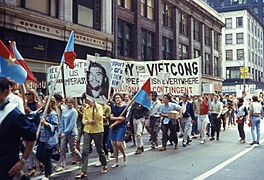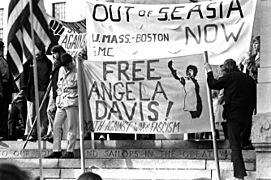Opposition to United States involvement in the Vietnam War facts for kids
Quick facts for kids Opposition to United States involvement in the Vietnam War |
|
|---|---|
| Part of the Counterculture of the 1960s, the Vietnam War and the Cold War |
|
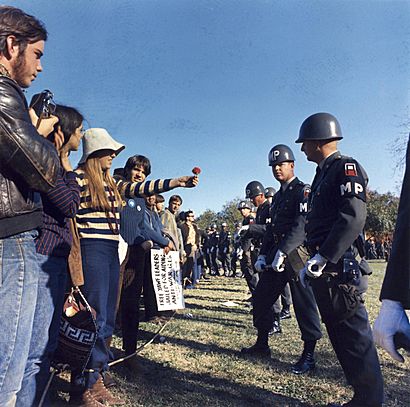
Anti-war protest at the Pentagon, 1967
|
|
| Date | 1964–1973 |
| Caused by | American involvement in Vietnam |
| Goals |
|
| Resulted in |
|
Many people in the United States did not agree with the country's involvement in the Vietnam War. This disagreement started with small protests in 1964. It grew into a large movement over several years. This movement helped shape the big debates in the U.S. during the late 1960s and early 1970s. People wanted to find a way to end the war.
Many people in the peace movement were young people, mothers, or youth who did not like the traditional way of life. The movement grew as African-American civil rights, second-wave feminist movements, and Chicano Movements joined in. Many other groups also got involved. These included teachers, religious leaders, writers, doctors like Benjamin Spock, and military veterans.
Most of their actions were peaceful. They used nonviolent methods. Sometimes, police used force against peaceful protesters. By 1967, more Americans thought the war was a mistake. Even Robert McNamara, who planned the war, later agreed.
Contents
- Why Did People Oppose the Vietnam War?
- How Did People's Opinions Divide?
- History of Protests Against the War
- Early Protests and Draft Card Burnings
- Government Reactions to Protests
- How Opinions Changed Over Time
- Protests Against the Draft System
- How War Events Changed Public Opinion
- The 1968 Presidential Election and Peace Talks
- Moratorium to End the War in Vietnam
- Winning "Hearts and Minds"
- Growing Divisions in Opinion
- Later Protests by Veterans
- Who Opposed the War?
- Political Responses to the War
- How Did Public Opinion Change?
- What Were the Effects of the Opposition?
- Timeline of Key Protests
- Organizations That Opposed the War
- Popular Slogans and Chants
- Images for kids
- See also
Why Did People Oppose the Vietnam War?
The Draft: A Major Reason for Protests
The draft was a system where young men had to join the military. It mainly picked people from minority groups and poorer families. This system caused many protests after 1965. Many felt the draft was unfair. This feeling made students and working-class Americans oppose it.
The protests happened during a time of big student activity. This followed the free speech movement and the Civil Rights Movement. The draft made many young people, called "baby boomers," get involved. But the movement grew to include many different kinds of Americans. People learned more about the war through TV news. This news showed what was happening in Vietnam.
Moral Reasons to Oppose the War
Many anti-war protesters also said the war was wrong. They believed it was not right for the U.S. to be involved. For example, a Quaker group protested in 1954. They worried America would get into a war in Indo-China. College students especially felt the war was "immoral." They thought the U.S. had selfish goals in Vietnam.
News about civilian deaths also fueled protests. Western media often did not show these deaths. But when photos of injured civilians appeared, people were shocked.
Was the War Legal?
Some Americans also questioned if the U.S. involvement was legal. The government said it was fighting communism (the domino theory). But some thought this was an excuse for America to control other countries. Others felt the U.S. was interfering in a civil war. They believed Vietnam should decide its own future.
How Did News Coverage Change Opinions?
TV news showed images of the war at home. This made many citizens lose faith. News reporters said the war seemed lost. For the first time, people saw battlefield images on TV. Pictures of injured soldiers made the idea of war seem less glorious. With no clear victory, American soldier deaths increased opposition.
How Did People's Opinions Divide?
Martin Luther King Jr. said in 1967, "If America's soul becomes totally poisoned, part of the autopsy must read 'Vietnam.'"
The U.S. became very divided over the war. Many supporters believed in the domino theory. This idea said if one country fell to communism, others nearby would too. This was a common fear after World War II. But critics said the war was political. They felt the military did not know how to win. Other critics said the South Vietnamese government was not truly in charge. They also felt supporting the war was wrong.
News media also played a big role in dividing opinions. In 1965, most news focused on military actions. There was little talk about why the U.S. was involved. After 1965, the media covered the disagreements at home. But they often left out the views of those who opposed the war.
The media created a debate between "Hawks" and "Doves." "Doves" were liberals who criticized the war. They said the war was a terrible mistake. But they did not question why the U.S. got involved. They just said it was not working. "Hawks" believed the war was right and could be won. They thought the media's criticism made people stop supporting the war. They blamed the media for the U.S. losing the war.
History of Protests Against the War
Early Protests and Draft Card Burnings
Early protests were led by Quakers in the 1950s. In November 1960, over a thousand Quakers held a silent protest. They surrounded the Pentagon for two days.
Protests against "the draft" started on May 5, 1965. Students at the University of California, Berkeley, marched to the draft office. Forty students publicly burned their draft cards. This was the first time this happened in the U.S. More cards were burned later. These protests were against the war's actions, not just the draft.
In July 1965, President Johnson doubled the number of men to be drafted. In August, he made burning a draft card a crime. On October 15, 1965, the first arrest for burning a draft card happened.
In November 1965, two anti-war activists set themselves on fire. This showed how strongly some felt the war was wrong. Norman Morrison, a Quaker, did this in front of the Pentagon. Roger Allen LaPorte, a Catholic Worker, did the same at the United Nations. They copied Buddhist protests in South Vietnam.
Government Reactions to Protests
The growing anti-war movement worried the U.S. government. In August 1966, the House Un-American Activities Committee (HUAC) investigated people suspected of helping the Viet Cong. They wanted to make these actions illegal. Anti-war protesters disrupted the meeting, and 50 people were arrested.
How Opinions Changed Over Time
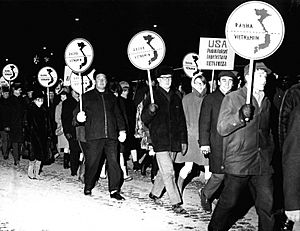

In February 1967, a famous essay called "The Responsibility of Intellectuals" was published. It was written by Noam Chomsky, a strong opponent of the war. He said that many smart people were helping the government justify its war policies.
Magazines like Time and Life supported the war at first. But in October 1967, their editor-in-chief, Hedley Donovan, changed his mind. He wrote that the U.S. went into Vietnam for good reasons. But the war became "harder, longer, more complicated." Donovan concluded the war was "not worth winning." He felt South Vietnam was not important enough to American interests. This made it wrong to ask young Americans to die for it.
Protests Against the Draft System
In 1967, the unfair draft system continued. It called up to 40,000 men each month. This fueled a growing movement against the draft. The draft favored white, middle-class men. This meant more young African American men were forced to serve. In 1967, 64% of eligible Black men were drafted, compared to 31% of eligible white men.
On October 16, 1967, people across the country turned in their draft cards. Over 1,000 cards were given to the Justice Department. This was an act of civil disobedience. Those who resisted expected to be arrested. But the Attorney General, Ramsey Clark, instead arrested leaders like Dr. Benjamin Spock. By the late 1960s, many court cases were about the draft. Over 210,000 men were accused of draft-related offenses.
To make the draft fairer, a lottery system started in 1970. A young man's birthday determined his risk of being drafted. However, most American soldiers in Vietnam were volunteers, not draftees.
How War Events Changed Public Opinion
On February 1, 1968, a Viet Cong officer was executed by a South Vietnamese general. This image became famous and helped turn U.S. public opinion against the war.
The Tet Offensive in early 1968 also changed public opinion. U.S. officials had said the war was going well. But the Tet Offensive showed shocking violence on TV. It also showed long lists of casualties. Americans felt the military had not been honest about the war's success. They began to doubt if a military solution was possible.
The 1968 Presidential Election and Peace Talks
In 1968, President Lyndon B. Johnson sought re-election. Eugene McCarthy ran against him, promising to end the war. McCarthy did surprisingly well. This led Johnson to announce on March 31 that he would not run again. He also announced peace talks with Vietnam. These secret talks began in Paris in August 1969.
Robert F. Kennedy also ran for president, opposing the war. Johnson's vice president, Hubert Humphrey, supported the war.
Moratorium to End the War in Vietnam
In May 1969, Life magazine published photos of American soldiers killed in one week. Many people were deeply affected by these pictures. On October 15, 1969, hundreds of thousands of people joined anti-war protests across the U.S. Many workers called in sick, and students skipped school. About 15 million Americans protested that day. This was the largest protest in a single day at that time. A second round of protests in November attracted even more people.
Winning "Hearts and Minds"
The U.S. government realized it needed the support of the South Vietnamese people. To win their "Hearts and Minds," the U.S. Army used "Civil Affairs" units. These units built schools, roads, and hospitals. They also provided medical care and training for civilians.
However, other parts of the war worked against this goal. The military focused on "body count" to measure success. Bombing villages caused civilian deaths. The My Lai massacre was a terrible example of civilians being killed. A 1974 documentary, Hearts and Minds, showed the war's damage to Vietnamese people. The South Vietnamese government also made its citizens angry. It arrested political opponents and held unfair elections.
Growing Divisions in Opinion
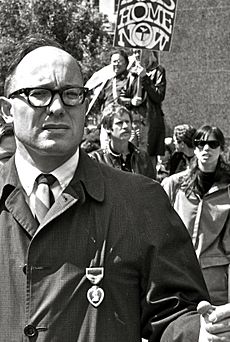
Despite the bad news, many Americans still supported the war. They believed in the domino theory. They also felt it was important to prevent a communist takeover. President Richard Nixon later spoke of "achieving Peace with Honor." Reports of Viet Cong violence also kept some support for the war.
But anti-war feelings grew stronger. Many opposed the war because of its violence. Others said it was a war against Vietnamese independence. Some felt it was interfering in a civil war. Others thought it had no clear goals and could not be won. Many Vietnam veterans joined the anti-war movement. They formed groups like Vietnam Veterans Against the War.
Later Protests by Veterans
In April 1971, thousands of veterans protested in Washington, D.C. Hundreds threw their medals onto the steps of the United States Capitol. Some radical protesters even displayed the flag of the Viet Cong. This action made many people who opposed the war feel uncomfortable.
Who Opposed the War?
As the war grew, more groups joined the movement.
African Americans and the War
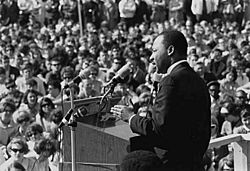
Earlier African-American leaders often opposed imperialism. For example, Paul Robeson supported Vietnam's fight for freedom. But during the 1960s, black leaders were careful about criticizing U.S. foreign policy.
By the mid-1960s, more black leaders spoke out. Malcolm X and Bob Moses voiced their opposition. Boxer Muhammad Ali risked his career and freedom by refusing the draft in 1966. Soon, Martin Luther King Jr., Coretta Scott King, and James Bevel became strong opponents of the war. The Black Panther Party also strongly opposed U.S. involvement. At first, some African Americans supported President Johnson because of his work on Civil Rights. But the war's violence and unfair draft soon pushed them to join anti-war groups.
In March 1965, King criticized the war during the Selma march. He said money for troops in Vietnam was needed to protect black rights at home. In 1965, the Student Nonviolent Coordinating Committee (SNCC) was the first major civil rights group to speak against the war. SNCC members helped lead protests against the draft. They used the slogan: "Hell no! We won't go!"
On April 4, 1967, King gave a famous speech called "Beyond Vietnam: A Time to Break Silence." He criticized President Johnson for "deadly Western arrogance." He said, "we are on the side of the wealthy... while we create a hell for the poor." Many people criticized King for this speech. But it showed his strong stand against imperialism.
King argued it was wrong for Black Americans to fight in Vietnam. They were treated as second-class citizens at home. He said the war took money away from the civil rights movement and programs to help the poor. Black anti-war groups often protested separately from white groups. They criticized the draft because it affected poor and minority men the most. In 1965 and 1966, African Americans made up 25% of combat deaths. This was more than double their share of the population.
Black women also played a role in the anti-war movement. They saw the war as racially motivated. They felt sympathy for Vietnamese women. This often led them to join or create new opposition groups.
Artists and Their Anti-War Messages
Many artists used their talents to oppose the war. Writers like Allen Ginsberg and poets like Denise Levertov wrote about the war's tragedy. Visual artists used war images to show who was responsible for the violence. Filmmakers made documentaries about anti-war marches. Playwrights used theater to share their thoughts. They often made fun of America's role in the world. They showed the horror of war next to normal life. These artists made Americans think more deeply about the war.
Asian Americans and the War
Many Asian Americans strongly opposed the Vietnam War. They saw it as another example of U.S. imperialism. They felt a connection between the unfair treatment of Asians in the U.S. and the war in Vietnam. They saw the war as "anti-Asian." Groups like the Asian American Political Alliance (AAPA) focused on opposing the war.
Their anger grew after the U.S. bombed Hanoi and mined Haiphong Harbor. Asian American activists carried banners saying, "Stop the Bombing of Asian People and Stop Killing Our Asian Brothers and Sisters." They wanted to build a strong movement against imperialism.
Asian Americans faced racism in the U.S. during the war. Soldiers of Asian descent were sometimes called "gooks." They were treated like the enemy. This racism led to women taking leadership roles in the Asian American anti-war movement. They spoke out against both racism and sexism.
Many Asian Americans spoke out because Vietnamese people were called "gooks" by the U.S. military. They also faced prejudice because they looked like "the enemy." This anti-Asian racism helped create a shared identity among different Asian American groups.
Asian American musicians also protested. The folk trio "A Grain of Sand" sang about anti-racism and anti-imperialism. Poets and playwrights also joined the movement. They showed how the war affected people.
Religious Leaders and Their Role
Religious leaders, or the clergy, also played a big role. Martin Luther King Jr. said, "the greatest purveyor of violence in the world today: my own government." He spoke out for an end to the war.
Many religious leaders did not believe in the war. They wanted to help end it. Different religions had their own views, but as a whole, the clergy were against the war.
Avoiding the Draft
The first draft lottery since World War II was held on December 1, 1969. It caused many protests. Some people said the lottery was unfair.
Anti-war groups offered advice on how to avoid the draft legally and illegally. Over 30,000 people left the U.S. to go to Canada, Sweden, and Mexico to avoid the draft. Some American soldiers were even helped to desert in Japan.
Many men went to college to avoid the draft. They had to stay in college until age 26. Some were rejected by the military for health reasons. Others joined the National Guard or the Peace Corps. These options raised concerns about fairness. Often, poor people or those without connections were drafted.
Some Americans who did not have to join the military protested paying taxes for the war. Refusing to pay war taxes became a more common protest. People like Joan Baez and Noam Chomsky refused to pay some taxes.
Musicians and Anti-War Songs
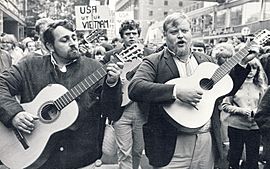
Many popular musicians opposed the war. This was different from World War II, when artists often supported the war. Musicians like Joni Mitchell, Joan Baez, and Phil Ochs used their music to protest. The two main types of music involved were Rock and Roll and Folk music.
Jimi Hendrix was a key figure in rock music. He protested the violence of the war. His song "Machine Gun" was dedicated to those fighting in Vietnam. He often asked for soldiers to come home. His songs became anthems for the anti-war movement. He showed that "you can love your country, but hate the government."
The song "The "Fish" Cheer/I-Feel-Like-I'm-Fixin'-to-Die Rag" by Country Joe and the Fish became a protest anthem. It used sarcasm to show the problems with the war. It also criticized people's naive attitudes.
Bob Dylan was another important figure. His folk and rock songs were part of the counterculture. Songs like "Blowin' in the Wind" and "The Times they are A-Changin'" spoke against the war. Dylan's songs aimed to wake up the public. Protesters felt his songs spoke for them.
John Lennon and Yoko Ono were also very famous activists. They held "bed-ins" where they stayed in bed and talked to the press about peace. Their song "Give Peace a Chance" became a global peace anthem.
Students and Their Protests
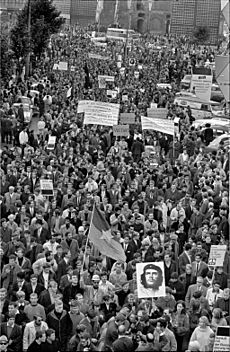
There was much unrest on college campuses in the 1960s. Students were involved in the Civil Rights Movement and the anti-war movement. Many students had the freedom to join these movements. They also felt they could make a difference. After World War II, America became richer. This led to a "beat generation" that did not follow traditional values. This led to the counterculture and hippies.
College enrollment grew to 9 million by the late 1960s. Colleges tried to control student behavior. But students wanted more freedom and a say in their education. Many joined the anti-war movement because they did not want to fight in a war they felt was not their concern. Others were against all war. Some disliked the war because it took money away from problems in the U.S.
Most student anti-war groups were local. They were easier to organize than national groups. Students protested by burning draft cards. They also protested universities sharing grades with draft boards. They protested military job fairs on campus. From 1969 to 1970, students attacked 197 ROTC buildings. Protests grew after the Kent State shootings. This made more students radical.
Women and the Anti-War Movement
Women were a big part of the anti-war movement. But they sometimes faced sexism within the groups. Some male leaders did not think women could contribute much. They believed women could not understand the movement because they were not affected by the draft. Women disliked the idea of violence in the war and the protests.
Despite these challenges, women gained experience organizing protests. They learned how to create strong anti-war messages. This led many women to form their own groups. Examples include Another Mother for Peace and Women Strike for Peace (WSP). Female soldiers in Vietnam also joined the movement.
Mothers and older women joined to advocate for peace. They were concerned about the war's effects on young men. They saw the draft as a bad part of the war. They tried to weaken the war by weakening the draft. These groups often offered free advice on how to avoid the draft. Members of Women For Peace held a peace vigil outside the White House every Sunday for 8 years. These groups often used the image of women as peaceful caretakers. The government saw these middle-aged women as dangerous. They were ordinary citizens who could quickly organize.
Many American women felt for Vietnamese civilians. They protested the use of napalm, a flammable jelly weapon. They boycotted Saran Wrap, made by the same company, Dow Chemical Company.
Some women felt frustrated by sexism in the anti-war movement. This led them to create their own groups. They wanted true equality for women in all parts of life. This led to the Women's Liberation Movement.
Political Responses to the War
Hearings in Congress
In April and May 1971, the United States Senate Committee on Foreign Relations held hearings. These were called the Fulbright Hearings. They discussed ways to end the war. On April 22, 1971, John Kerry became the first Vietnam veteran to speak to Congress against the war. He called for the U.S. to leave Vietnam immediately. Kerry shared stories from veterans who had seen or committed terrible acts during the war.
How Did Public Opinion Change?
American public support for the Vietnam War went down as the war continued. As support decreased, opposition grew.
In August 1965, a Gallup poll asked if sending troops to Vietnam was a "mistake." Only 24% said yes, while 60% said no. Three years later, in September 1968, 54% said it was a mistake, and 37% said it was not.
In 1965, few Americans wanted to join a public protest. Those who did often supported the war. But in 1990, when asked if they wished they had protested more, 25% said yes.
| Urge to Organize or Demonstrate | Yes % | No % | |||||||||||||||||||||||||||||||||||||||||||||||||||||||||||||||||||||||||||||||||||||||||||||||||
|---|---|---|---|---|---|---|---|---|---|---|---|---|---|---|---|---|---|---|---|---|---|---|---|---|---|---|---|---|---|---|---|---|---|---|---|---|---|---|---|---|---|---|---|---|---|---|---|---|---|---|---|---|---|---|---|---|---|---|---|---|---|---|---|---|---|---|---|---|---|---|---|---|---|---|---|---|---|---|---|---|---|---|---|---|---|---|---|---|---|---|---|---|---|---|---|---|---|---|---|
| U.S. adults | 10 | 90 | |||||||||||||||||||||||||||||||||||||||||||||||||||||||||||||||||||||||||||||||||||||||||||||||||
| 21 to 29 years old | 15 | 85 | |||||||||||||||||||||||||||||||||||||||||||||||||||||||||||||||||||||||||||||||||||||||||||||||||
| 30 to 49 years | 12 | 88 | |||||||||||||||||||||||||||||||||||||||||||||||||||||||||||||||||||||||||||||||||||||||||||||||||
| 50 and older | 6 | 94 | |||||||||||||||||||||||||||||||||||||||||||||||||||||||||||||||||||||||||||||||||||||||||||||||||
| College graduates | 21 | 79 | |||||||||||||||||||||||||||||||||||||||||||||||||||||||||||||||||||||||||||||||||||||||||||||||||
| High school graduates | 9 | 91 | |||||||||||||||||||||||||||||||||||||||||||||||||||||||||||||||||||||||||||||||||||||||||||||||||
| High school nongraduates | 5 | 95 | |||||||||||||||||||||||||||||||||||||||||||||||||||||||||||||||||||||||||||||||||||||||||||||||||
| Gallup, Oct. 29 – Nov. 2, 1965 | |||||||||||||||||||||||||||||||||||||||||||||||||||||||||||||||||||||||||||||||||||||||||||||||||||
A big reason for disapproval was the number of U.S. soldiers getting hurt or killed. A 1967 poll asked what troubled people most. The top answer (31%) was "the loss of our young men." Another poll asked how the war affected families. Most (55%) said it had no effect. Of those affected, 32% listed rising prices, and 25% listed casualties.
As the war went on, more people opposed it because it seemed endless. In December 1967, 71% believed the war would not end in 1968. A year later, 55% did not think it would end in 1969.
In the 1990s, when asked about the anti-war movement, 39% approved, and 39% disapproved.
What Were the Effects of the Opposition?
The opposition to the Vietnam War had many effects. Many believe it helped end U.S. involvement. Historian Howard Zinn said the anti-war movement was the biggest the nation had ever seen. He believed it played a key role in ending the war.
Some others, like Michael Lind, disagree. They say the public turned against the war because it was too costly. They do not think the protests were the main reason.
Fewer Soldiers Available
One effect was that fewer soldiers were available for the army. People protested the draft and ROTC programs. In May 1969, a draft center reported that 2,400 out of 4,400 men did not show up for induction. In early 1970, the draft system could not meet its goals.
Student protests against ROTC programs led to them being canceled at over forty colleges. In 1966, over 191,000 students were in ROTC. By 1973, that number dropped to about 72,000.
College Campuses Shut Down
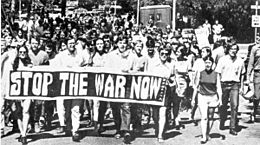
Another effect was that many college campuses shut down due to protests. These protests put pressure on the government. Colleges like Brown University, Kent State University, and the University of Massachusetts saw major unrest.
At the University of Massachusetts, the 1969 graduation was a protest for peace. Students wore armbands and peace symbols. At Boston College, 6,000 people gathered to protest the war. At Kent State University on May 4, 1970, National Guardsmen shot into a crowd of students. Four students were killed. At Brown University in 1969, two-thirds of the graduating class turned their backs when Henry Kissinger spoke.
American Soldiers' Feelings Changed
The opposition also affected American soldiers in Vietnam. Some began to question what they were doing. A soldier in a POW camp wondered who the enemy was. He said, "Until we got to the first camp, we didn't see a village intact; they were all destroyed. I sat down and put myself in the middle and asked myself: Is this right or wrong? Is it right to destroy villages? Is it right to kill people en masse? After a while it just got to me." This shows how the destruction and unclear goals of the war affected soldiers. They began to feel a sense of opposition too.
Timeline of Key Protests
1964
- May 12: Twelve young men in New York publicly burned their draft cards.
- August: After the Gulf of Tonkin incident, Congress passed the Gulf of Tonkin Resolution.
- December: Joan Baez led 600 people in an anti-war protest in San Francisco.
1965
- March 24: Professors organized a "teach-in" protest at the University of Michigan. 2,500 people attended. This idea spread to 35 other campuses.
- March 16: Alice Herz, an 82-year-old pacifist, set herself on fire to protest the war.
- April 17: The Students for a Democratic Society (SDS) and the Student Nonviolent Coordinating Committee (SNCC) led the first anti-war march in Washington, D.C. About 25,000 people protested.
- May: Draft-card burnings happened at the University of California, Berkeley.
- May: A Gallup poll showed 48% of Americans thought the government was handling the war well.
- May: The first anti-Vietnam War protest in London happened outside the U.S. embassy.
- June: Protests were held at the Pentagon. In August, activists tried to stop trains carrying troops.
- August: A Gallup poll showed 24% of Americans thought sending troops to Vietnam was a mistake.
- October 15: About 40 people held a sit-in at the Ann Arbor, Michigan, draft board. They were arrested.
- November 2: Norman Morrison set himself on fire in front of the Pentagon.
- November 27: Coretta Scott King, Carl Oglesby, and Dr. Benjamin Spock spoke at a large anti-war rally in Washington, D.C. President Johnson announced a big increase in U.S. troops.
1966
- February: About 100 veterans tried to return their military medals to the White House.
- March 26: Anti-war protests happened around the world. 20,000 people protested in New York City.
- May 15: 10,000 people protested outside the White House.
- June: Gallup poll showed support for U.S. handling of the war dropped to 41%.
- July 3: 4,000 people protested in London. 33 were arrested.
- Joan Baez and A. J. Muste organized over 3,000 people to protest war taxes.
- Three army privates, the "Fort Hood Three," refused to go to Vietnam. They were sent to prison.
- Heavyweight boxing champion Muhammad Ali refused to join the military. He was sentenced to prison, lost his title, and was banned from boxing. His conviction was later overturned.
1967
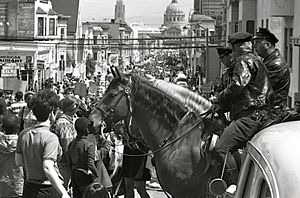
- January 14: 20,000–30,000 people gathered for a "Human Be-In" in San Francisco.
- February: 2,500 members of Women Strike for Peace marched to the Pentagon.
- February 8: Christian groups held a nationwide "Fast for Peace."
- March 12: An anti-war ad with 6,766 teachers' signatures appeared in The New York Times.
- March 17: Anti-war citizens marched to the Pentagon.
- March 25: Martin Luther King Jr. led a march of 5,000 against the war in Chicago.
- April 4: Martin Luther King Jr. gave his "Beyond Vietnam" speech.
- April 15: 400,000 people marched in New York City. 100,000 marched in San Francisco.
- April 24: Abbie Hoffman led protesters who threw money onto the floor of the New York Stock Exchange.
- May 2: Bertrand Russell held the "Russell Tribunal," a mock war crimes trial.
- June 1: Vietnam Veterans Against the War was formed.
- June 23: A large anti-war protest met President Johnson in Los Angeles. Police clashed with protesters.
- July 30: Gallup poll showed 52% of Americans disapproved of Johnson's handling of the war.
- August 28: U.S. Representative Tim Lee Carter called for troops to come home.
- September 20: Over 1,000 members of WSP rallied at the White House.
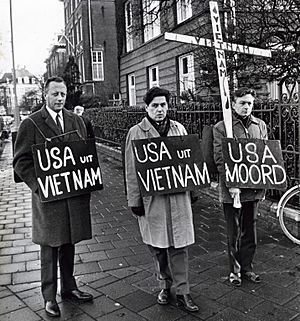
- October: "Stop the Draft Week" led to clashes and over a thousand draft cards returned.
- October 18: Students at the University of Wisconsin–Madison tried to stop Dow Chemical Company from holding a job fair. Police ended the protest.
- October 21: The March on the Pentagon took place. Nearly 100,000 people gathered. Some tried to "levitate" the building. Clashes with soldiers and police led to 647 arrests.
1968
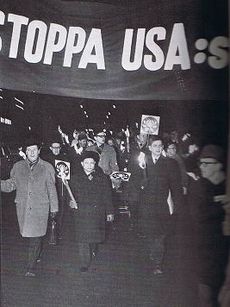
- January 15: Over 5,000 women rallied in D.C. for the Jeannette Rankin Brigade protest.
- January 18: Singer Eartha Kitt spoke out against the war to Lady Bird Johnson at the White House.
- January 30: The Tet Offensive began. It led to higher casualties and changed public views.
- February: Gallup poll showed 50% disapproved of Johnson's handling of the war.
- March 12: Anti-war candidate Eugene McCarthy did well in the New Hampshire primary.
- March 16: Robert F. Kennedy joined the presidential race as an anti-war candidate.
- March 17: A major rally outside the U.S. Embassy in London turned into a riot.
- March: Gallup poll showed 49% felt involvement in the war was a mistake.
- April 17: An anti-war riot at Columbia University was filmed by national media.
- April 26: A million college and high school students boycotted class.
- April 27: An anti-war march in Chicago ended with police beating marchers.
- August 26–29: During the 1968 Democratic National Convention in Chicago, anti-war protesters clashed with police. This became known as a "police riot."
- August: Gallup poll showed 53% said sending troops to Vietnam was a mistake.
1969
- March: Polls showed 19% wanted the war to end soon.
- March 5: Senator J. William Fulbright was stopped from speaking by veterans.
- April 6: A spontaneous anti-war rally was held in Central Park.
- May 22: Canada announced it would not ask about military status for immigration.
- July 16: Activist David Harris was arrested for refusing the draft. His wife, Joan Baez, toured to raise awareness.
- July 31: The New York Times reported 53% approved of Nixon's handling of the war.
- August 15–18: The Woodstock Festival was held. Peace was a main theme.
- October 15: The Moratorium to End the War in Vietnam demonstrations took place. Millions protested.
- October: 58% of Gallup respondents said U.S. entry into the war was a mistake.
- November 15: Half a million people protested in Washington, D.C., and San Francisco.
- December 7: The 5th Dimension performed "Declaration" on the Ed Sullivan Show.
- Late December: The "And babies" poster was published.
- End of year: 69% of students identified as "doves."
1970
- March 14: Two merchant seamen, protesting the war, diverted a U.S. ship carrying napalm bombs.
- May 4: 100,000 anti-war protesters gathered in Washington, D.C., to protest the invasion of Cambodia.
- National Student Strike: More than 450 campuses were shut down by student strikes. Over 4 million students were involved.
- May: Gallup poll showed 56% believed sending troops to Vietnam was a mistake.
- June 13: President Nixon created a commission to study campus unrest.
- July: The documentary The World of Charlie Company showed soldiers close to mutiny.
- August 24: A building at the University of Wisconsin-Madison was damaged during a protest.
- August 28–September 3: Vortex I, a government-sponsored rock festival, was held near Portland, Oregon, to prevent violence from planned protests.
- August 29: The Chicano Moratorium saw 25,000 Mexican Americans protest in Los Angeles. Police clashed with the crowd.
1971 and After
- April 23, 1971: Vietnam veterans threw away over 700 medals at the Capitol.
- April 24: Anti-war organizers claimed 500,000 marched, making it the largest protest since 1969.
- May 5, 1971: 1,146 people were arrested trying to shut down Congress during the 1971 May Day Protests.
- August 1971: The Camden 28 raided draft board offices in New Jersey.
- December 26, 1971: 15 anti-war veterans occupied the Statue of Liberty.
- March 29, 1972: 166 people were arrested in Harrisburg, Pennsylvania, protesting a trial.
- April 19, 1972: Students protested renewed bombing by breaking into campus buildings.
- May 13, 1972: Protests spread after Nixon decided to mine harbors in North Vietnam.
- July 6, 1972: Four nuns prayed to protest the war during a White House tour. This led to many arrests.
Organizations That Opposed the War
- Another Mother for Peace
- Asian American Political Alliance (AAPA)
- Asian Americans for Action (AAA)
- Bay Area Asian Coalition Against the War (BAACAW)
- Black Women Enraged
- Catholic Workers Movement
- Central Committee for Conscientious Objectors
- Clergy and Laymen Concerned about Vietnam (CALCAV)
- Committee for a Sane Nuclear Policy (SANE)
- Committee for NonViolent Action (CNVA)
- Concerned Officers Movement
- Fellowship of Reconciliation
- GI Coffeehouses
- GI's Against Fascism
- The League of Women Voters
- Movement for a Democratic Military
- National Black Anti-War Anti-Draft Union (NBAWADU)
- National Black Draft Counselors (NBDC)
- Sisters of Notre Dame de Namur
- SNCC
- Student Peace Union
- Students for Democratic Society (SDS)
- Third World Liberation Front (TWLF)
- Vietnam Veterans Against the War
- War Resisters League
- Women's International League for Peace and Freedom (WILPF)
- Women Strike for Peace (WSP)
- WIN (Workshop in Nonviolence) Magazine
Popular Slogans and Chants
- "Hell, no, we won't go!"
- "Bring the troops home now!"
- "Dow shall not kill." and "Making money burning babies!" (against Dow Chemical Company)
- "Stop the war, feed the poor."
- "Girls say yes to men who say no."
- "War is not healthy for children and other living things."
- "End the nuclear race, not the human race."
- "Not my son, not your son, not their sons."
- "Ho, Ho, Ho Chi Minh, the Viet Cong are gonna win."
- "Hey, hey, LBJ! How many kids did you kill today?" (against President Lyndon B. Johnson)
- "আমার নাম তোমার নাম ভিয়েতনাম" (Your name, My Name Vietnam)
Images for kids
Propaganda
Protests
-
Anti-Vietnam War protest. Vancouver, British Columbia, Canada. 1968.
See also
 In Spanish: Protestas contra la guerra de Vietnam para niños
In Spanish: Protestas contra la guerra de Vietnam para niños


